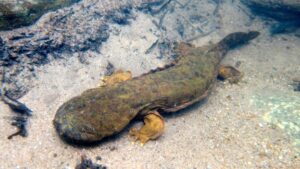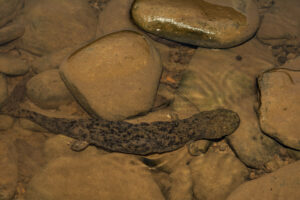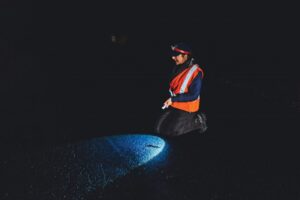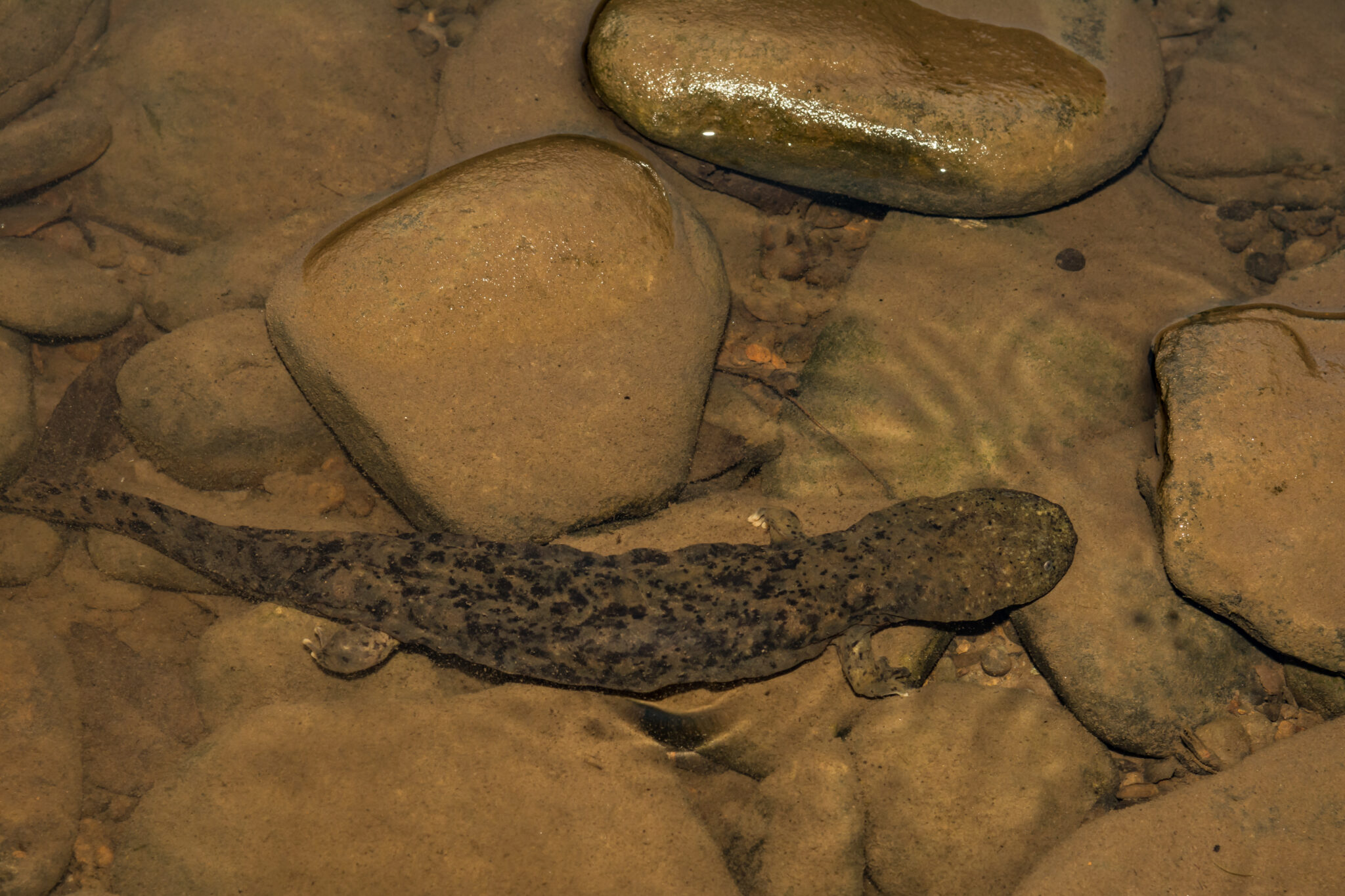Secretive Salamanders
Writer / Ryan Hynes, Interpretive Ranger at The Parklands of Floyds Fork
Photography Provided
What is it about salamanders that makes them so mysterious? You may have seen these lizard looking creatures skittering along the ground in your yard hiding under garden stones, fallen logs, leaf piles or even your trashcan! But these lizard looking creatures are not lizards at all. In fact, they are not even reptiles! Salamanders are amphibians making them one of the most vulnerable types of wildlife in our area. Kentucky is home to 35 salamander species of the 300 species that have been identified worldwide- many of which can be found in the forests and streams of The Parklands of Floyds Fork.
creatures are not lizards at all. In fact, they are not even reptiles! Salamanders are amphibians making them one of the most vulnerable types of wildlife in our area. Kentucky is home to 35 salamander species of the 300 species that have been identified worldwide- many of which can be found in the forests and streams of The Parklands of Floyds Fork.
However, you may not have noticed any salamanders at The Parklands lately. That’s because, during the winter, salamanders undergo a process called brumation, which is similar to the hibernation some mammals like bears undergo. Amphibians and reptiles undergo brumation rather than hibernation due to their inability to control their internal body temperatures. Cold-blooded animals must be more creative in their attempts to control their body temperature, such as basking on a log to warm up or burrowing themselves in the mud to cool down. Brumation typically lasts for a shorter period than hibernation as well, potentially lasting only a month or two and is often interrupted due to the need for water and food- or even to go to the bathroom!
Once it begins to warm up again like it is now, salamanders begin to emerge from their brumation so that they can move to vernal pools throughout the forest to find a perfect mate. Vernal pools are temporary pools in the forest floor that are filled with melted snow or spring rain and often dry out by the end of the summer. Salamanders commonly choose to rest for the winter nearby the sites where these pools begin to form, causing this “mini” migration to be far smaller than that of other mammals or birds. Vernal pools are important breeding habitat for many amphibians including salamanders and frogs because these shallow pools lack fish that commonly feed on their young. [Vernal pool 2]
Due to their secretive nature, the life cycle of the salamander is not fully understood, but scientists are working harder than ever to understand these amphibians. Conservation concerns have fueled the rapid growth of salamander studies throughout the state. Kentucky’s Wildlife Action Plan, a statewide effort to ensure the health and diversity of the state’s vulnerable species, identifies 14 different salamander species as species in great need of conservation efforts, including the Hellbender (Cryptobranchus allegheniensis), the largest salamander in Kentucky. [Hellbender]
Salamander conservation is vital to our Kentucky ecosystem. They fulfill a crucial role as a link between small invertebrates and larger mammals on the food chain. Salamanders commonly prey upon invertebrates such as mosquitos, ticks, and flies, serving as the ecosystem’s natural form of pest control- making salamanders a natural bug deterrent during our spring picnics! Salamanders are also an important food source for other park animals like fish, raccoons, and birds of prey like owls. They are also considered to be an indicator species within the forests of Kentucky. An indicator species is one whose population number highlights the overall health of a habitat. The presence of more salamanders means the system is doing well overall. Salamanders and other amphibians also give scientists a rough assessment of water quality in their environment due to their ability to breathe through their skin, leaving them highly susceptible to pollutants in our waterways. Scientists can use their population in certain areas to determine the level of pollutants in the water. [vernal pool]
Of the dangers that salamanders face during their lives, humans pose the biggest threat. One of the major dangers that humans pose to salamanders is habitat destruction. Clearing parts of a forest for development can unknowingly lead to the destruction of a vernal pools local salamander populations have been using for generations. Without these vernal pools, these animals would be  required to lay their eggs in areas with a higher number of predators. Secondly, road mortality has a significant impact on the health of amphibian populations, especially salamanders. Many salamanders are killed due as they cross roadways that pass through their migration path towards a vernal pool. There are many citizen-science projects that aim to mitigate these effects by training volunteers to help shepherd crossing amphibians. Equipped with flashlights, reflective vests, and rain gear, these volunteers ensure that salamander populations can safely continue their migration and successfully breed. [salamander crossing]
required to lay their eggs in areas with a higher number of predators. Secondly, road mortality has a significant impact on the health of amphibian populations, especially salamanders. Many salamanders are killed due as they cross roadways that pass through their migration path towards a vernal pool. There are many citizen-science projects that aim to mitigate these effects by training volunteers to help shepherd crossing amphibians. Equipped with flashlights, reflective vests, and rain gear, these volunteers ensure that salamander populations can safely continue their migration and successfully breed. [salamander crossing]
Unfortunately, their migration is not always easy to predict. It occurs during a cool, rainy evening when the ground begins to thaw, and temperatures are warm (above 40°F). When these conditions are met, salamanders will begin to move from their brumation sites towards the vernal pools. It is also important to note that not all salamanders migrate at once. Precipitation levels and temperatures can fluctuate throughout a region, causing the large migration to occur over time throughout the area in several movements. Rather than having one massive movement of salamanders, it is often broken up into several smaller movements towards vernal pools. The nature of salamander migration makes it relatively difficult to be able to observe. However, conducting daily checkups on the weather report can give you the best chance to predict when their migration conditions are met and allow you to observe a group of secretive salamanders!
If you do end up having the opportunity to observe a salamander migration event, it is important to know how to handle these delicate creatures. Their sensitive, permeable skin requires extreme care from humans when handling these creatures. It is best practice to avoid direct contact with salamanders due to their sensitive skin. Always ask yourself: “Do I need to handle this animal to appreciate it?” Using a small net will ensure that no soap/lotion residue seeps into the salamander’s skin. Disposable gloves are another option for amphibian handling. If you’re unable to use a net while you stumble across a salamander, always ensure that your hands are wet and clear of contaminants. Bringing a small, clean, clear container to use as a viewing area will help minimize the time they’re in contact with you.
As with all animal handling, it is safest to wash your hands or change gloves between individuals. Handling these animals can be a stressful experience for them, so always make sure to place them back where they were found as quickly as possible if you have to pick them up. [holding a salamander]
Now that you’ve got the basics of salamander handling down, you’re set to embark on your own and look for these forest friends! It’s best to search during rainy weather and during early mornings. Like all amphibians, they prefer to stay in cool, damp, or wet areas. Looking under logs, rocks or leaf piles can reveal salamanders or any other fascinating native species we have in Kentucky!
With our numerous healthy streams and creeks, The Parklands of Floyds Fork is a fantastic place to go observe salamanders in their preferred habitat. Any paddling access found around the parks can offer many hiding spots for salamanders to use. The Osage Orange Trail in Beckley Creek, Boone Bottoms Trail in Turkey Run, and Riparian Ramble in Broad Run are three fantastic places to begin your search for aquatic salamanders. The Paw Paw Trail in Turkey Run and Coppiced Woods Trail in Beckley Creek are two good sites to begin looking for terrestrial salamander species. Nearly all of The Parklands is considered the preferred habitat of many salamander species.
Osage Orange Trail in Beckley Creek, Boone Bottoms Trail in Turkey Run, and Riparian Ramble in Broad Run are three fantastic places to begin your search for aquatic salamanders. The Paw Paw Trail in Turkey Run and Coppiced Woods Trail in Beckley Creek are two good sites to begin looking for terrestrial salamander species. Nearly all of The Parklands is considered the preferred habitat of many salamander species.
Next time you’re at The Parklands, make sure to look closely on your hike for these well camouflaged amphibians as they can be found all throughout the parks system!






